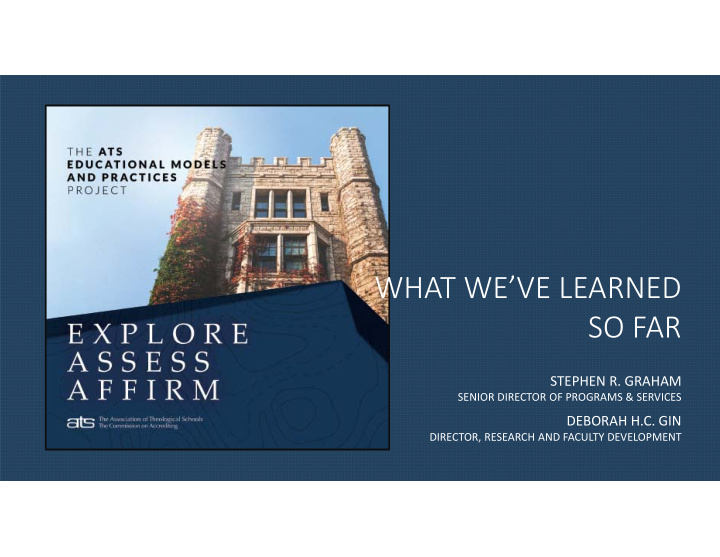



WHAT WE’VE LEARNED SO FAR STEPHEN R. GRAHAM SENIOR DIRECTOR OF PROGRAMS & SERVICES DEBORAH H.C. GIN DIRECTOR, RESEARCH AND FACULTY DEVELOPMENT
ED MODELS MAPPING SURVEY: DEANS
RESIDENTIAL CHARACTER OF THE STUDENT BODY Average Student Residence Percentage Live on/adjacent to campus 27% Local commuter 47% Non‐local commuter 26%
BUSY SCHOOLS! • Course delivery methods • Schedule, calendar modifications • Educational partners • Alternative Tuition/fee structures • Programs to serve particular constituencies • Other curricular innovations
EDUCATIONAL PARTNERSHIPS Church/denomination 172 College/university 107 Other theological school 79 Institute/center 70 International partner 63 Other religious tradition 42
SCHEDULING: “CURRENTLY DOING . . . .” Some Exclusively Evening 154 31 Intensive 154 22 Block 120 54 Weekend 96 10 Year Round 80 18
PROGRAMS FOR PARTICULAR CONSTITUENCIES Of those responding “currently doing” Hispanic/Latino(a) 38% Asian/Asian North American 22% African American/Black 21% Native American/First Nations 7% “Diversity” 12%
PEER GROUPS 18 groups 110+ schools Emerging issues Examples
ED MODELS MAPPING SURVEY: PROGRAM DIRECTORS
THE SAMPLE • 440 Participants (120 CAOs) • 200 Different schools • Good representation (ecclesial family, country, embeddedness)
Challenges Purposes Effectiveness
EFFECTIVE PROGRAMS (ALL SCHOOLS) Enhanced student learning Response Program (1‐4 Scale) Competency‐Based Education* 3.8 Contextual Education 3.6 Team Teaching 3.6 *Small sample size
Strengthened school’s reputation and Clarified school’s mission Response Program (1‐4 Scale) Partnership with Institute 3.5/3.3 Partnership with International Partner 3.4/3.3 Particular constituency: Global 3.4/3.4 Competency‐Based Education 3.5/3.8 Continuing Education 3.4/3.5 Integrative Courses 3.5/3.5
Enrollment growth Response Program (1‐4 Scale) Fully Funded Degree Program 3.3 Particular Constituency: Diaconate* 3.3 Particular Constituency: Urban* 3.3 Competency‐Based Education 3.3 Greater access to prospective students Fully Online Degree Program 3.7 Fully Online Courses 3.5 Fully Funded Degree Program 3.5 *Small sample size
Improved school’s financial picture Response Program (1‐4 Scale) Specialized Programs (e.g., specializations w/i degrees)* 3.3 Integrative Courses* 3.2 Fully Online Degree Program 3.0 Contextual Education 3.0 Year‐Round Study 3.0 Fully Funded Degree Program 3.0 Local Church Subsidy 3.0 Particular constituency: Chaplains* 3.0 Particular constituency: Diaconate* 3.0 *Small sample size
Programs effective in all/most areas: Evangelical Mainline Roman Catholic/Orthodox Contextual Education Contextual Education Contextual Education Particular constituency: Local Church Subsidy Fully Funded Degree Diaconate Program Partnership with Year‐Round Study International Partner Particular constituency: Weekend Classes Racial/Ethnic Curricular innovation: Evening Classes Technology Local Church Subsidy EFFECTIVE PROGRAMS (BY ECCLESIAL FAMILY)
“Bottom line” Mission/Reputation Competency‐Based Education Contextual Education Integrative Courses Student Learning > Mission & Finances
CHALLENGES (ALL SCHOOLS) Overall, All Programs Frequency Insufficient staff/ human resources to invest in program 22.5% Insufficient financial resources to make needed 13.7% changes Lack of clear understanding of what is needed among 12.9% target constituency (Last) Restrictions in the standards of accreditation 6.1%
CHALLENGES (ALL SCHOOLS) Programs Associated with Certain Challenges Challenge Program Faculty Fully/Partially Online Courses, Synchronous resistance Video/Tech Accrediting Accelerated (Bachelors‐to‐Masters), Change standards in Hours, Competency‐Based Education Low Extension Site, Weekend/Evening, Enrollment Diaconate, Laity, Dual Degree, Non‐Degree Lack of student No Bachelors preparation
Small Mid Large Largest Roman Catholic/ Human Resources Human Resources Human Resources Human Resources Evangelical Mainline Orthodox Low Enrollment Financial Resources Financial Resources Understanding Target Human Resources Human Resources Human Resources Understanding Target Low Enrollment Faculty Resistance Understanding Target Financial Resources Understanding Target Technological Resources Low Enrollment Financial Resources Understanding Target Financial Resources Understanding Target Financial Resources Financial Resources Technological Technological Technological Technological Low Enrollment Low Enrollment Low Enrollment Resources Resources Resources Resources … … … Insufficient Planning Faculty Resistance Faculty Resistance Low Enrollment Accrediting Standards Insufficient Planning Student Preparation Student Preparation Student Preparation Student Preparation Insufficient Planning Accrediting Standards Faculty Resistance Accrediting Standards Accrediting Standards Insufficient Planning CHALLENGES (BY SCHOOL TYPE)
Freestanding Embedded Human Resources Human Resources Financial Resources Understanding Target Low Enrollment Understanding Target Financial Resources Low Enrollment Technological Resources Faculty Resistance Student Preparation Faculty Resistance Accrediting Standards Technological Resources Insufficient Planning Insufficient Planning Student Preparation Accrediting Standards CHALLENGES (BY SCHOOL TYPE)
PURPOSES (ALL SCHOOLS) OVERALL Frequency To reach a new constituency 20.1% To recruit students 18.7% To respond to student requests 14.4% To respond to requests from 12.2% church/denomination/community
PURPOSES (ALL SCHOOLS) Partnerships To recruit students To reach a new constituency To respond to requests from church/denomination/community To promote diversity in the community Programs for Particular Constituencies To reach a new constituency To recruit students To respond to requests from church/denomination/community To promote diversity in the community
Purposes Purposes Purposes Reach new constituencies Reach new constituencies Reach new constituencies Recruit students Recruit students Recruit students Requests (student/church) Requests (student/church) Requests (student/church) Challenges Challenges Resources, resources, resources Resources, resources, resources Understanding target Understanding target Effectiveness Effectiveness Competency‐Based Ed Competency‐Based Ed Contextual Ed Contextual Ed Integrative Courses Integrative Courses
Mapping the Religious Workforce Innovation & FD Grants Study of Other Graduate Professional Education NEXT STEPS
Recommend
More recommend